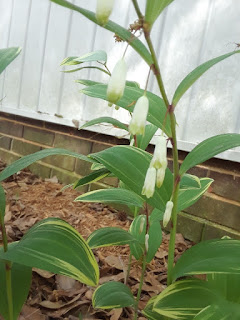Wednesday, April 4, 2018
more bloomers...
... called Solomon's Seal (polyganatum biflorum). Comes up from a little rhizome that you think is dead, deceased, completely lost when the greenery dies off in the fall. Making you forget about it in the bleak winter. Then suddenly a little green shoot starts coming up from the brown drab leaf mulch and you say: Oh! Wow. Having forgotten it was ever even planted there - then before you realize it has blooms, appearing on the underside of the stalk between the oval leaves, with tiny bell shaped flowers. And say: Spring!
The name comes from a scar on the rhizome that appears to have a similarity to the 'seal' used by King Solomon, son of David from the Old Testament. Biblical history reports he was wise and fair, and that small circular 'seal' or scar that is named for the King supposedly gives an indication of the age of the rhizome. Count the number of scars to judge the age of the plant. According to my research, the berries are poisonous, but the rhizome/root has a number of natural/homeopathic uses for medicating skin, heart, bones, etc.
I bought it several years ago at the Callaway Gardens plant sale, and put it in a bed that gets nearly no direct sun as I knew it was a shade lover. But it did not seem to thrive, and I thought perhaps it needs more light than it gets up close to the house under that three-foot-wide overhang. After I relocated to a different spot where they do get full sun for a couple of hours each day, especially early in the year before the deciduous trees begin to leaf out, they seem much happier.
Well mulched, and in some really good dirt that appears to suit them better. I expect they will grow (some think it invasive!) as it is native to the south and midwest US, get to the point that they will reproduce, so I can dig and spread out to fill that shady bed better. I love things that have variegated leaves, with lighter colors mixed in with the green. And really like those tiny little bell-like blooms that remind me of those wee little white flowers on the earliest bulbs when the snowdrops appear. Yay, Spring!
Subscribe to:
Post Comments (Atom)


No comments:
Post a Comment